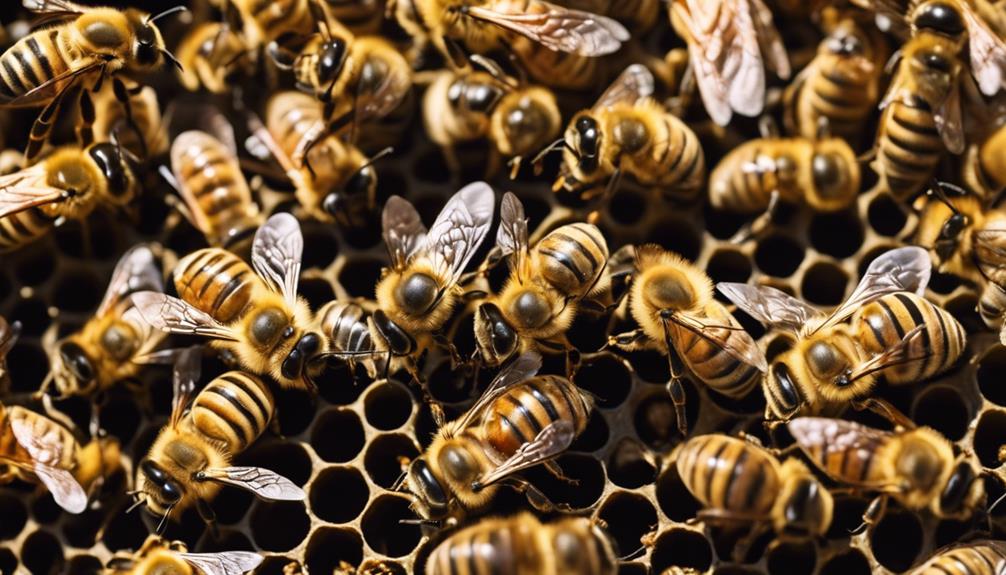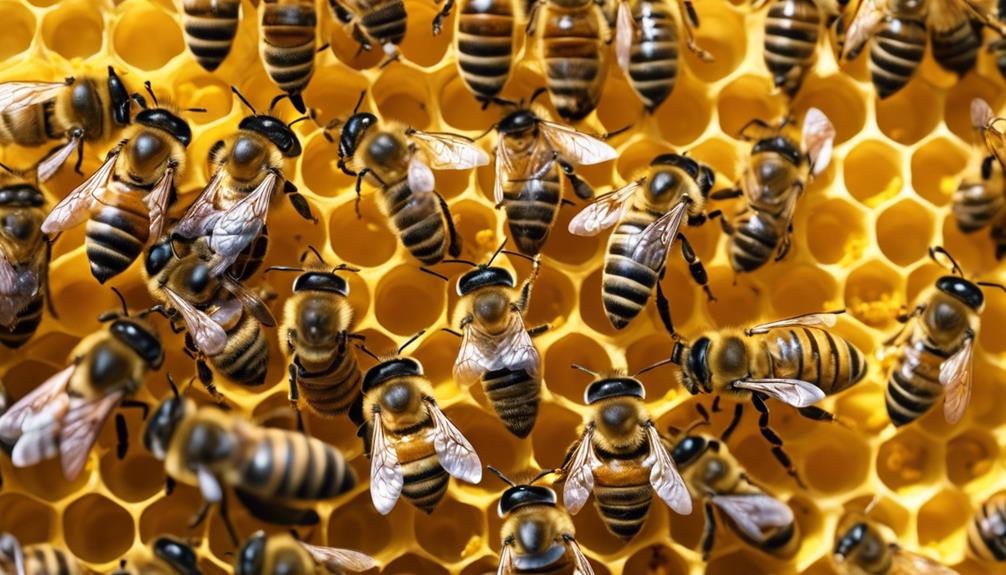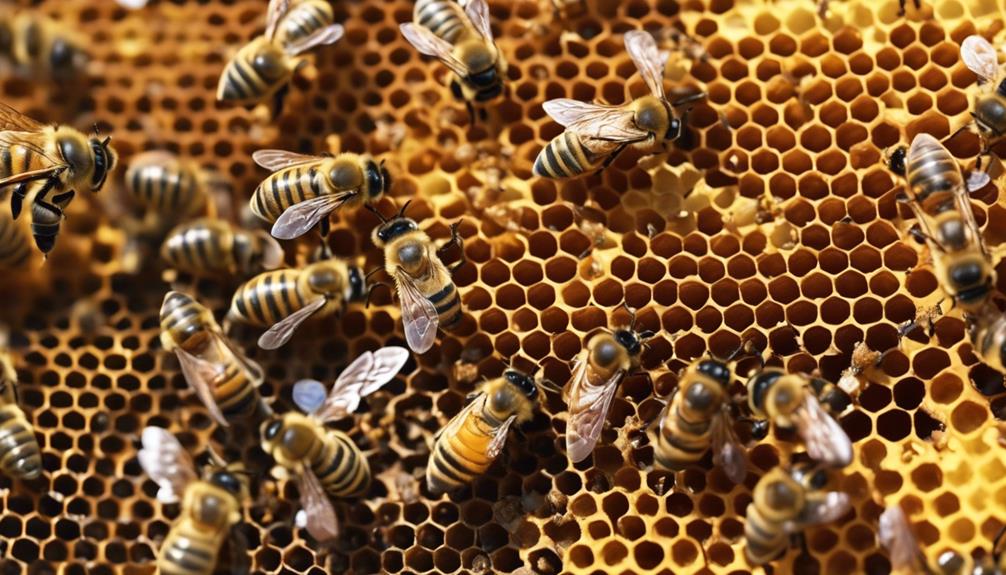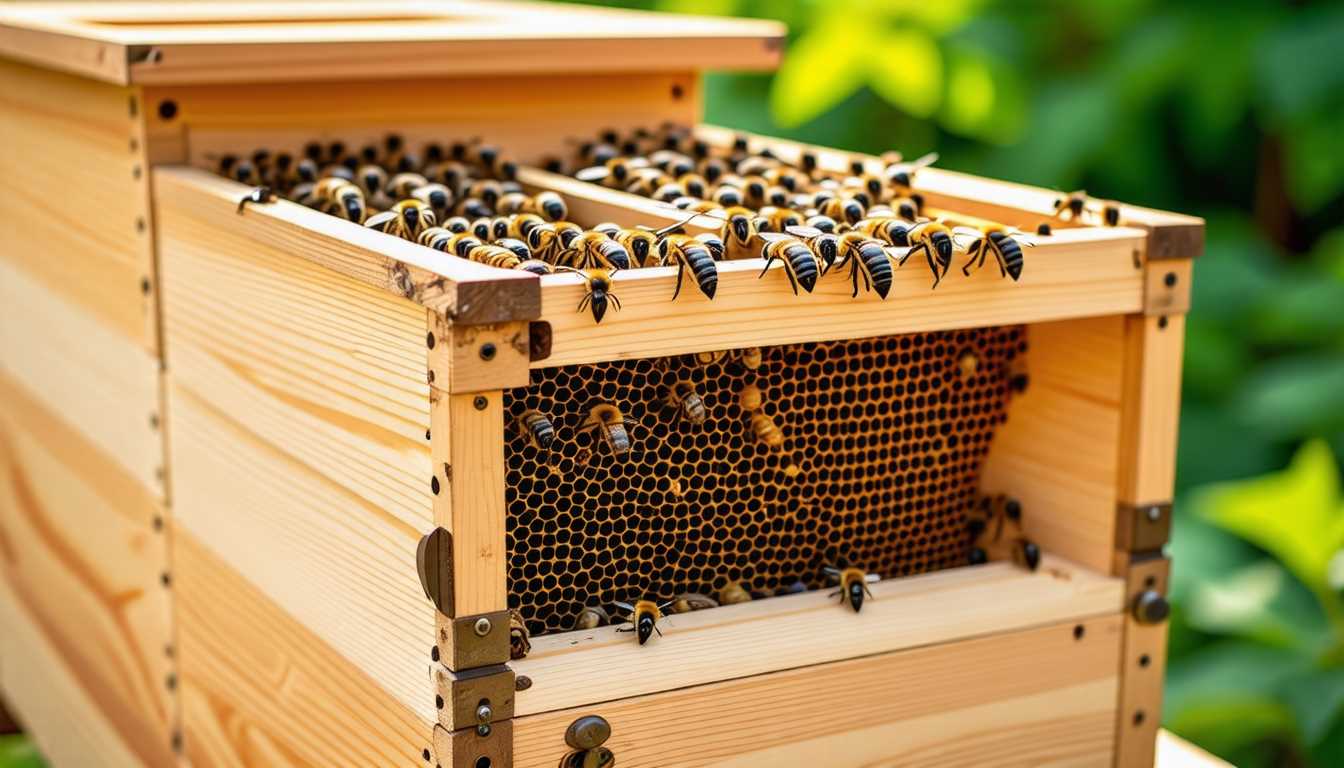Worker bees are all female because they play vital roles in maintaining the hive, gathering resources, and caring for future generations. Their genetic makeup and specialized tasks guarantee the smooth operation and survival of the entire bee community. These female bees work tirelessly to support the queen, maintain the hive, and contribute to the overall productivity of the colony. The intricate social structure and division of labor among female worker bees are essential for the hive’s functionality and long-term success. Understanding why worker bees are exclusively female reveals fascinating insights into the complex world of bees and their fascinating society.
Main Points
- Worker bees are female due to genetic predisposition for hive organization and task specialization.
- Female worker bees have limited reproductive capabilities compared to the queen.
- The division of labor in worker bees is crucial for the long-term success and survival of the colony.
- Worker bees contribute significantly to hive maintenance, productivity, and gene propagation.
- Female worker bees play essential roles in supporting the queen bee and ensuring colony functionality.
Reproductive System of Worker Bees
Exploring the reproductive system of worker bees reveals their unique genetic composition and specialized role within the hive. Female worker bees, though possessing functional ovaries, have limited reproductive capabilities. This limitation stems from their genetic makeup, inheriting two sets of chromosomes that dictate their development into non-reproductive individuals.
While they have the potential to produce eggs, these eggs remain unfertilized due to the absence of mating. This genetic predisposition plays an essential role in the hive organization, ensuring that worker bees focus on tasks essential for the colony’s survival rather than reproduction.
Social Structure of Honeybee Colonies
The genetic predisposition of female worker bees to inherit a full set of chromosomes from the queen shapes the social structure of honeybee colonies, defining their roles and responsibilities within the hive. Female workers, with their unique genetic makeup, play essential roles in the hive’s functioning through a well-defined division of labor.
- Task Specialization: Female workers take on diverse tasks like foraging, nursing the brood, and maintaining hive structure, ensuring the colony’s smooth operation.
- Supporting the Queen: These worker bees assist the queen bee in her egg-laying duties and overall colony management.
- Colony Survival: The efficient division of labor among female workers is crucial for the long-term success and reproductive capabilities of the entire honeybee colony.
Role of Queen Bee in Egg Fertilization

How does the queen bee’s role in egg fertilization shape the genetic composition of a honeybee colony?
The queen bee, with her magical touch, holds the key to the colony’s future. By selectively fertilizing eggs, she determines the destiny of her offspring. Female worker bees, essential for the hive’s daily operations, arise from fertilized eggs brimming with potential.
On the flip side, the queen leaves male drone eggs unfertilized, setting them on a different path. This strategic act not only influences the sex of the bees but also allocates roles within the colony.
With up to 1,500 eggs laid per day, the queen’s precision ensures a bustling population ready to work harmoniously. Her dance of fertility orchestrates the thriving symphony of the hive.
Division of Labor in Bee Colonies
Let’s discuss how bees divide up the workload!
In a hive, each bee has a specific role to play, contributing to the overall success of the colony. Worker bees tackle tasks like building the hive, maintaining it, and gathering food for their sisters.
This division of labor guarantees that the queen can focus on laying eggs and the workers can keep the hive running smoothly.
Role Specialization in Bees
Always working tirelessly within the colony, female worker bees exhibit remarkable specialization in various tasks, ensuring the hive’s efficiency and productivity. This division of labor among worker bees plays an essential role in the smooth functioning of the hive. Here are three key points to understand their role specialization:
- Efficient Task Allocation: Worker bees are adept at managing a wide array of responsibilities, from cleaning and nursing to foraging and hive maintenance, ensuring that each task is carried out effectively.
- Genetic Influence: Genetic characteristics such as infertility and altruistic behavior drive the specialization of worker bees, making them well-suited for their roles within the colony.
- Colony Productivity: By dedicating themselves to supporting the colony and ensuring gene propagation, worker bees contribute significantly to the overall productivity and success of the hive.
Worker Bee Tasks
Worker bees in a colony exhibit a clear division of labor, each undertaking specific tasks essential for the hive’s functioning. Female bees, being infertile, focus on colony maintenance duties vital for the hive’s survival. These tasks include foraging for food, caring for the young, building and repairing the hive, and guarding the entrance.
The genetic relatedness among female bees drives this behavior, ensuring that the genes they carry are passed on indirectly through their sisters and the queen. This evolutionary strategy prioritizes the success of the hive as a whole rather than individual reproduction.
Queen Bee Responsibilities
Responsibly, the queen bee oversees key aspects of the hive’s operation, guaranteeing the colony’s continuity through her vital role in reproduction and leadership.
- Lay Eggs: The primary responsibility of the queen bee is to lay eggs. She’s capable of laying up to 2,000 eggs per day during the peak season, guaranteeing the colony’s population growth and sustainability.
- New Queen: In the case of the current queen’s decline in egg-laying ability or death, the queen bee is responsible for selecting and nurturing a new queen. This ensures the seamless transition of leadership within the hive.
- Workers Collect: The queen bee also releases pheromones that regulate the behavior and development of worker bees. These pheromones guide the workers in their tasks, such as collecting nectar and pollen, maintaining the hive, and caring for the brood.
Female Worker Bees Essential Tasks
Females in a bee colony play essential roles in guaranteeing the hive’s survival by performing indispensable tasks such as foraging, nursing the brood, cleaning the hive, and protecting it.
Worker bees, who are all female, have specific hive responsibilities determined by a well-defined division of labor. This division ensures that each female worker bee can efficiently carry out her duties, contributing to the overall health and productivity of the colony.
Their genetic makeup and instincts are finely tuned to drive their dedication to these critical tasks. As female bees, they’re anatomically and genetically equipped for these specialized roles within the hive structure.
The evolutionary adaptation of female worker bees underscores their importance in maintaining the hive’s functions and promoting its longevity.
Survival Mechanisms in the Colony

As worker bees, we excel at various roles vital for the colony’s survival.
From foraging to nursing the brood, we contribute selflessly to the hive’s well-being.
Our genetic predisposition leads us to defend the colony, maintain its infrastructure, and distribute labor for efficient reproductive success.
Female Bee Roles
In ensuring the survival of the hive, female worker bees play crucial roles through their dedicated tasks such as foraging, nursing, and hive maintenance.
- Female bees engage in foraging, collecting nectar and pollen to sustain the colony’s nutrition.
- Worker bees excel in nursing duties, caring for the young brood and ensuring their development.
- Hive maintenance tasks, like building and repairing comb structures, fall under the responsibility of female bees.
These specialized roles showcase the efficient division of labor within the colony, where each worker bee contributes distinctly to the collective well-being. Their selfless dedication underscores the harmonious functioning of the hive, ensuring the continuity and prosperity of their shared home.
Colony Defense Strategies
With a keen sense of vigilance, the colony’s defense strategies are orchestrated by the dedicated female worker bees. These amazing creatures play an essential role in hive defense, using their stinging mechanism as a powerful weapon against any threats.
The evolution of this defense mechanism showcases the strategic adaptation of worker bees to protect their home from predators and intruders. Male bees, lacking stingers, focus more on mating and less on hive defense.
It’s fascinating to see how the female worker bees instinctively prioritize the safety of the queen and the entire colony. Their evolutionary adaptation as females ties directly to their critical function in safeguarding the genetic lineage and ensuring the continuity of the hive.
It’s truly remarkable how each bee plays a specific role in ensuring the colony’s survival.
Reproductive Division of Labor
Our focus shifts to the intricate survival mechanisms within the colony through the Reproductive Division of Labor.
- Female worker bees contribute to genetic survival by supporting their siblings and future queens.
- The division of labor in the hive is orchestrated to prioritize gene propagation through indirect means.
- This strategy results in the exclusive female worker bee population, as male bees focus on direct gene propagation through mating with queens from other hives.
The evolutionary sacrifice of female worker bees for genetic survival leads to their specialized role as the primary workers in the hive. By understanding this division of labor, we gain insight into the complex and efficient mechanisms that drive the colony’s success.
Significance of Female Worker Bees

Female worker bees play an essential role in the hive’s functionality through their specialized genetic and anatomical traits. Their genetic makeup and infertility drive their selfless dedication to tasks crucial for the hive’s survival.
As all female offspring of the queen, worker bees establish a smooth division of labor within the colony. The queen’s fertilization of female eggs guarantees a workforce ready to forage, nurse, and build, enhancing the hive’s efficiency.
Despite their inability to reproduce, female worker bees indirectly contribute to the survival and propagation of their genes by supporting their siblings and the overall hive population. This intricate system highlights the critical significance of female worker bees in maintaining the hive’s well-being and productivity.

Hello! My name is Noel Calvin. I graduated from UCLA and now work as a writer at Launch Ninjas. I write blog posts that inspire and guide our readers in their entrepreneurial pursuits. I live in Pleasantville, NJ, with a peaceful yet lively atmosphere that inspires me.
Writing stories is more than just a job for me. It allows me to share my observations and satisfy my curiosity about the world. I combine my analytical skills with creative enthusiasm to delve into technology trends and startup stories. But my life isn’t limited to screens and keyboards. I value loyalty, passion, and a touch of old-fashioned charm, which I infuse into every narrative I create.
I love spending time in my garage, jamming with my band when I’m not writing. Playing the guitar and singing bring me immense joy. I also enjoy capturing ordinary and extraordinary moments through my camera lens and exploring new culinary adventures that excite my taste buds. I’m always seeking new experiences.
My family is very important to me. Joyful Sunday brunches filled with laughter and intense board game nights keep me grounded, reminding me of life’s simple pleasures.
In my world, every moment is an opportunity for discovery. Every discovery is a story worth sharing, whether a heartfelt moment at home or the pulse of technological innovations. Join me as I navigate through life, one blog post, one guitar strum, and one heartwarming family dinner at a time.


